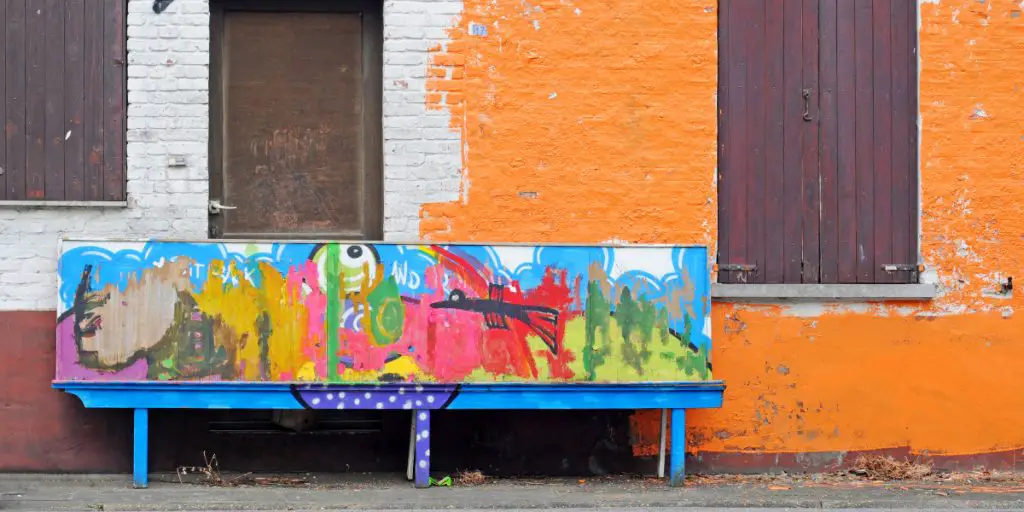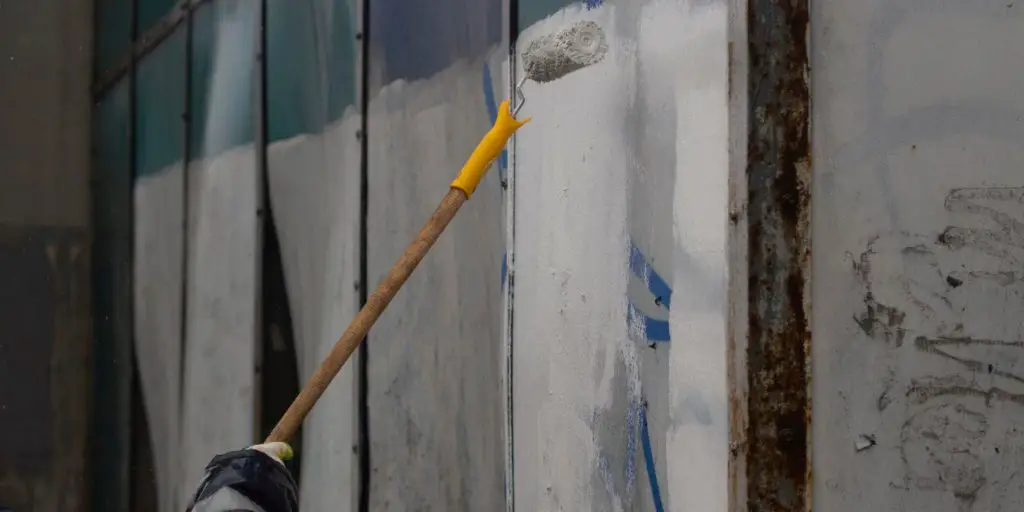While a piece of Banksy artwork on the side of your house could see resale value rocketing, generally speaking, graffiti is bad news. How do you remove graffiti from brick?
One way to remove graffiti from brick is to use a pressure washer with a graffiti remover solution. Alternatively, a mixture of hot water and baking soda can also be used as a mild abrasive to gently scrub away the graffiti.
It may also be necessary to use a wire brush or sandpaper for stubborn stains. It is important to test any cleaning solution on a small, inconspicuous area first to ensure it does not damage the brick.
Whether you’ve been the victim of a one-off act of vandalism, or your property is situated in a prime graffiti hotspot, knowing how to deal with rogue spray paint properly will prevent any permanent damage being done – and keep the property commercially appealing.
Is graffiti legal on private property?
As a property investor who rents property out you might be wondering if it’s something of a grey area when it comes to your residents ‘decorating’ the outside of the property.
Graffiti is not legal on private property without the owner’s permission. It is considered vandalism and can result in fines, legal action, and damage to the property.
If you find your own tenants have graffiting your property without consent, you should take action to clean it off and if necessary, pursue them for any accidental damage caused.
Graffiti is considered vandalism as it is the act of defacing public or private property without permission. It is often considered a form of illegal expression that can damage the property and cost money to clean up.
If the graffiti is from an outside source, the best way to deal with the problem is to contact your local authority or graffiti removal service – they will be able to advise on what steps need to be taken in order to remove the graffiti quickly and safely.
Do councils remove graffiti?
Many councils have graffiti removal teams or services that can remove graffiti from public spaces such as buildings or walls. It is important to report any graffiti to the local council, so they can take appropriate action to remove it.
Graffiti removal on private property is typically limited to areas facing public highways and requires written consent from the property owner.

Are off the shelf products graffiti removal products any good?
The first inclination when dealing with graffiti is to shop online or visit a local DIY superstore, hunting for the right product amongst a host of graffiti removal products for the one that promise to work wonders.
You’ll find wipes, sprays, and brush-on solutions – but it’s very difficult to find any products that have more than a small handful of good reviews.
The reason is simple; there’s nothing that comes close to the effectiveness of calling in a graffiti removal specialist.
The kind of products that are readily available to the public might suffice for dealing with a bit of marker pen on the door of a toilet cubicle, but the people who are spraying or stencilling onto buildings are equipped with a variety of industrial-grade paints.
The spray-paints that even the most casual graffiti artist uses are extremely weatherproof – and they’re designed to cling hard to all manner of surfaces, drying very quickly.
For the £15-£20 or so that you might spend on a pack of graffiti wipes, you might think they’re worth a try – but be warned, they may end up costing you more, further down the line.
The problem is, these products represent a ‘one-size-fits-all’ solution to removing paint – but the people spraying your building don’t stick to one kind of paint.
Graffiti can be brushed on, sprayed, rollered – even thrown on – and the paint used can be anything from household gloss to specialist acrylics made and sold specifically for street or graffiti art.
Poor attempts at removing graffiti are so common they even have a place in the lexicon of graffiti artists – a ‘ghost’ is the name given to a paint stain or shadow that remains after their handy-work has been badly removed.

What are the problems graffiti can cause
Graffiti is often seen as a form of self-expression or art, but it can also cause a number of problems for both individuals and communities. In this article, we’ll explore 5 problems that graffiti can cause.
1. Property Damage
One of the most obvious problems with graffiti is that it can cause property damage. Graffiti can be difficult and expensive to remove, especially if it’s done on a porous surface like brick or concrete. Property owners may have to hire professionals to remove the graffiti, which can be costly.
2. Decreased Property Value
Graffiti can also decrease property values in a neighbourhood. When buildings and structures are covered in graffiti, it can give the impression that the area is run-down and unsafe. This can make it difficult for property owners to sell their homes and businesses, and can also discourage new businesses from moving into the area.
3. Increased Crime
Studies have shown that areas with high levels of graffiti can also have higher levels of crime. Graffiti can attract other criminal activity, such as drug use and vandalism. It can also make people feel unsafe, which can lead to a decrease in community involvement and an increase in crime.
4. Health Risks
Graffiti can also pose health risks to individuals who come into contact with it. Graffiti often contains harmful chemicals and toxins, such as lead and mercury. If these chemicals are inhaled or absorbed through the skin, they can cause a range of health problems, including respiratory issues and neurological damage.
5. Negative Impact on Tourism
Finally, graffiti can have a negative impact on tourism in a city or town. If visitors see that a city is covered in graffiti, they may be less likely to visit or recommend the area to others. This can have a significant impact on local businesses that rely on tourism to survive.
In conclusion, while graffiti may seem harmless, it can cause a range of problems for both individuals and communities. It’s important to address graffiti in a timely and effective manner to minimize these negative impacts.
Finding a good removal service
The kind of equipment you need to tackle graffiti effectively is likely to run into thousands of pounds, and that’s before you have the formal training required to learn how to use and handle it safely. As such, using the service of a well-equipped and reputable graffiti removal team makes solid financial sense. You can also book painters in Hawthorn or your local area to help you repaint your home that’s been tarnished by graffiti.
As well as being able to handle the chemicals and tools needed to remove graffiti, a good service will also usually be able to safely work at height. This is especially useful since many graffiti artists appear to able to create their particular brand of art in all manner of precarious places – some well above ground level.
Although you’ll need to check your specific policy, you’ll find that many insurance companies cover against graffiti – so the cost of professional help is limited to a fairly modest excess most of the time too.
Prevention vs cure
If you own or manage a building that appears to be a constant target for vandals and their spray cans, then talking to a specialist cleaning service about sealing the surfaces in question might be a good long-term plan.
Wax-based semi-permeable coatings can be sourced for a huge range of surfaces, and while they prevent paint adhering, they don’t stop the surface ‘breathing’ so you don’t have to worry about issues with brickwork, concrete or stone moving forward.
Of course, a sealed surface won’t stop people trying to apply their art to your building – but it does mean that a bucket of soapy water and a sponge will remove it; making tackling on-going graffiti issues a lot less stressful!
Sources
https://www.cleanedwithcare.co.uk/graffiti-removal/
https://www.reuters.com/article/us-crime-graffiti-idUSTRE4AJ78Q20081120
https://www.qstartech.com/graffiti-attracts-crime/
- Manchester’s Office Market Revival: A Bold Turn Toward Growth and Investor Confidence - April 20, 2025
- Renters on Universal Credit Left Struggling as Housing Payments Frozen Despite Benefit Increases - April 19, 2025
- Uk’s Single-Family Rent Market Booms With Unprecedented £2.5bn Surge—What It Means for Investors - April 4, 2025


